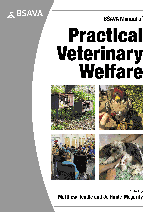
Full text loading...

The ability to assess welfare in a quantifiable way, recognize when intervention may be required and then implement necessary changes is vital for the entire veterinary team and any regular caregivers. This chapter provides different tools for recording welfare in a quantitative manner, so that poor welfare can be flagged and improved. The chapter also contains printable resources: a hospitalization form, admissions questionnaires for small mammals, reptiles, birds and birds of prey, and behaviour questionnaires for dogs, cats and rabbits. This chapter also contains eight downloadable froms that can be printed and used as part of a welfare assessment.
Assessment and recording methods tool kit, Page 1 of 1
< Previous page | Next page > /docserver/preview/fulltext/10.22233/9781910443798/BSAVA_Manual_Welfare_1_9781910443798.2.18-70-1.gif

Full text loading...





















Supplements